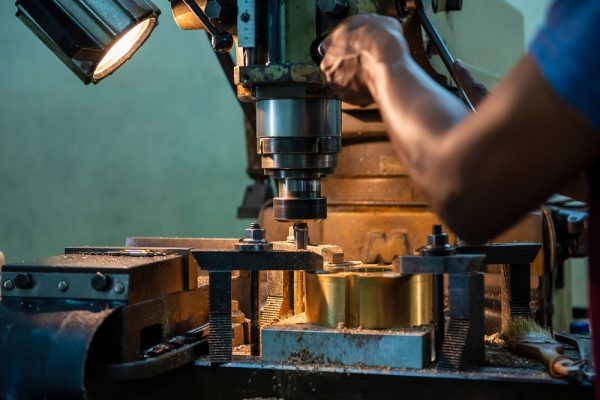A Guide to Metal Milling
Milling refers to the process where the milling tool cuts the materials in the form of a rotary motion. Like drilling, metal milling is possible with different varieties of tools that have different degrees of hardness and diameters. As the mill keeps moving, the rotational speed has to be high to get a clean finishing of a milled hole. The need is to be optimum between the rotational speed, required quality, and moving speed.
What happens during milling?
The time needed to produce a given number of parts consists of the cycle time and the initial setup time for every part. Setup time comprises the time to set up the metal milling machine, installing the fixture device to the milling machine, and planning the movements of the too. The cycle can constitute the following.
-
Load and unload time
The time needed to load a workpiece into a milling machine and secure it to a fixture, along with the time to unload one finished part, is called the load and the unload time. The load time can vary depending on the complexity, size, and weight of the workpiece with the kind of fixture.
-
Idle time
The non-productive time is the time needed for tasks that happen at the time of the process cycle that does not remove the material or engage the work piece. This ideal time comprises retracting and tool approaching from the workpiece, adjusting the settings of the machine, movements of the tool between the features, and changing the tools.
-
Cut time
The cut time is the required time for the cutter to make the essential cuts in a workpiece for every operation. You can calculate the cut time for any particular operation just by dividing the total length of the cut for that given operation by the feed rate, that is, the cutter’s speed relative to a workpiece.
-
Time of tool replacement
The replacement time of a tool comes when it exceeds its lifetime and becomes, therefore, worn to effectively cut any work piece. It does not generally happen in every cycle but only after it reaches the lifetime of the tool. In figuring out the cycle time, the time of the tool replacement can be adjusted for a single part’s production by multiplying the tool replacement frequency, that is, the cut time, by the lifetime of the tool.
Components of a milling machine
-
Horizontal milling machine
Horizontal milling machines get their name from the tool’s positioning. The axis of the machines lies horizontally. Horizontal mills are used mainly for the purpose of end milling.
A horizontal mill’s build is quite simple. The arbor is attached to the cutting tool. When the alteration of a tool is required, you can remove an arbor bracket, including the spacers, to replace the tools.
Fixing the workpiece on the working table is called a vise. The traverse is able to the table on the X, Y, and Z axis for moving a workpiece. Newer machines appear slightly different, making them suitable for any automation. Horizontal centers of milling can come with many spindles with some tools for quick turnaround times. Also, the table and the tools can move in most directions along the rotational axes.
With the help of horizontal milling, one can produce parts with a few operations. It is how you can create complex parts. It is three to four times faster in comparison to vertical milling and has a longer tool life. Additionally, it has a better surface finish.
-
Vertical milling machine
In a vertical milling machine, the tool axis positioning is vertical. It is best suited for end milling. There are particular differences between a vertical and a horizontal milling machine. But, the significant components are quite similar.
The machine head is at the end of the ram, and the spindle for the cutting tools is attached to the head. Everything around the table’s positioning is similar to the horizontal milling machine, providing it with the ability to move in three identical directions.
The modern vertical five-axis mills provide possibilities for the parts to rotate more and offer faster turnarounds. Automating the results of the movement will provide quick lead times and better accuracy.
Vertical milling is cheaper than horizontal mills, with a four to five-times price difference. More workshops can afford them, so their affordability is more. It is easy to use because a vertical milling machine has better visibility. The machines are small and require less space.
Milling precision correction
-
Y axis milling calibration
You can loosen the three bolts slightly, but you have to ensure that the three bolts are not much loose for facilitating fine-tuning work. You can make use of the arm rotating bolt to place the dial indicator on the shaft’s end face for measuring the correct position of a work table.
-
X axis milling calibration
In axis milling calibration, you can loosen the four bolts, but you have to pay attention to whether the four bolts come with frictional resistance. Presently, one can use the head for rotating the bolts and adjusting the right and left angles. During this process, a dial indicator has to be placed on the main shaft’s end face to measure the work table’s correct position.
Conclusion
We have discussed what happens during metal milling. For instance, there is the load and unload time. In addition, we have also discussed the two different types of milling machines. One is horizontal milling machines, and another is vertical machine milling. You can also calibrate the X and the Y axis. If you are currently looking for a milling service, you can reach out to Crescocustommetals.com. Apart from metal milling, you can find many quality services here. They will help you carry out your metal fabrication process at an affordable price.


